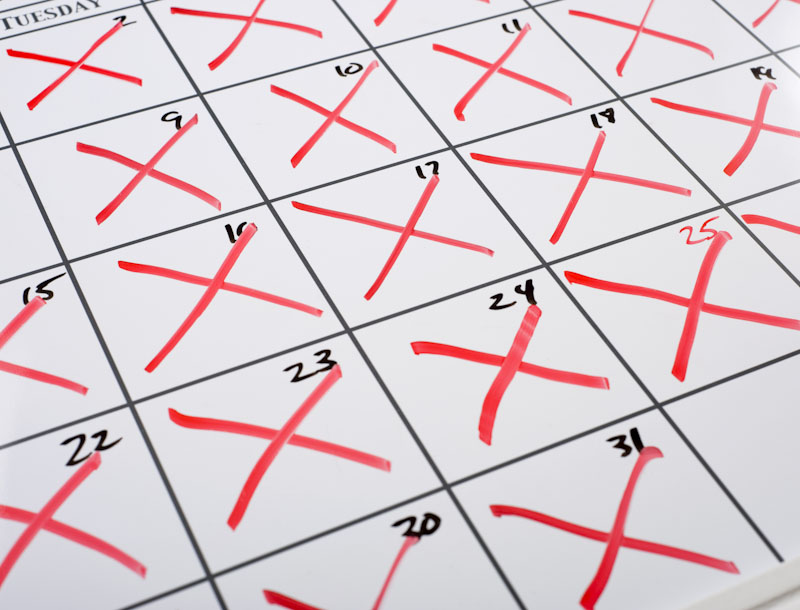Everyone loves the New Year.
Originally celebrated as a victory lap, where the cavemen would dance and get drunk to celebrate another year of avoiding becoming the saber-tooth tiger’s dinner; New Year’s celebrations haven’t changed much. We still dance and get drunk, only now our saber-tooth tigers are much more dangerous than before.
But aside from the frivolity in our New Year’s celebrations, the New Year holds a much more significant meaning; that of giving us all a new opportunity at life. We have a chance to get right, the things we got wrong before. We can get a fresh start on those things we didn’t get done. We can reset the clock on the procrastination that we had before.
Not only that, but the New Year serves as a convenient benchmark for checking ourselves out and reviewing how we are doing in life. We can all ask ourselves the question, “How am I doing today, compared to how I was doing this time last year?” As opposed to any other time of the year, because it is the New Year’s, we probably have a pretty good idea of exactly where we were and how we were doing a year ago.
That’s important for we who call ourselves preppers; for prepping isn’t a destination, but rather a journey. We never really reach the point where we can finally say, “Now I am prepared.” Rather, we reach a bunch of smaller milestones, where we can look back and say, “I am better prepared in this area and to survive this type of disaster than I was before.”
We can also use the New Year as an opportunity to look forwards, establishing new goals for the coming year. Those goals are important, as they provide us with a measurable standard for the things we will be doing. They give us a clear direction in which to travel. They also give us a way of measuring our success.
Take Stock of Where You Are
There are a number or things I like to do at the beginning of the year. These things don’t have to be done right on January 1st, but I try and accomplish them within the first few weeks of the year. A large part of that is that I know if I don’t get them done quickly, they’ll never get done.
The first of these is to take inventory of my preps. Since my prepping permeates every part of my life, that means taking inventory of all my life, not just my stockpile. But the stockpile is an important part of that. It’s important to lay eyes on everything in our stockpiles from time to time, just to make sure that everything is still there and still in usable condition.
In the past, I’ve found food and other supplies which have gone bad or have been damaged by insects and rodents. Believe it or not, canned goods can actually go bad. It’s rare; but it happens. It seems that every once in a while, the acid-resistant coating on the inside of a can gets damaged. When that happens, the acid in the food in that can attacks the metal and can eventually eat its way through. Once there’s a hole in the can, bacteria can get inside, spoiling the food. Let’s just say, it’s messy when that happens.
I’ve also had cases where rats have gnawed their way through a five-gallon bucket to get to what was inside. In defense of the buckets’ reputation, I have to admit that there was no sealed Mylar bag inside, nor was the bucket properly sealed. In one case in particular, it was the bucket I keep my dog’s food in. Even so, at least one rat decided it wanted to get in that bucket and did.
Then there have been the times when I thought I had something in my stockpile, only to find that some larger mice… the two-legged, teenage variety, had gotten into those containers and eaten what was inside them. If it hadn’t been for my yearly habit of taking inventory, I wouldn’t have known I needed to replace that food my kids had eaten.
Some things, like gasoline, need to be replaced on a regular basis. Better yet, the stock should be rotated constantly, so that you are always sure to have fresh stocks on hand. The beginning of a new year provides me with an excellent opportunity to ensure that’s actually happening. If I’m not sure, I can easily use up the stock that I have and replace it with new stocks, without it costing me a dime, as I have to buy gasoline on a regular basis anyway.
But there’s more to taking inventory, than taking a physical inventory. I also like to take inventory of where I am mentally and emotionally. What new skills have I learned in the past year? What skills have I let slide a bit? How is my survival attitude? Am I ready to switch over normal mode to survival mode at a moment’s notice?
How about my health? One of the areas which is easily overlooked in our disaster preparedness is how ready we are to take on the physical challenges of survival. Am I “in shape?” (and I’m not referring to round as a shape here). How are my vital signs? Is there any medical necessity that I’ve been putting off? (I’m notorious for that). These are important issues that need to be taken care of, if we expect ourselves to be ready in a survival situation.
Expanding out from there, I look at my mental and spiritual life overall. Life is a journey of improvement. We shouldn’t stop “growing up” when we hit 21. Rather, we should continue to grow in the more important things of the character. I use the New Year as an opportunity to check those things too.
Make a Plan for the Year
Taking stock of where I am does two things for me. First, it allows me to see the progress I’ve made in the last year. I never want to have a year where there isn’t any progress. Rather, I want to be able to see clear and dramatic differences in who I am and what I’ve accomplished, each time I look back.
But there’s second part of that too. Taking stock allows me to establish a new benchmark for next year’s comparison. Without that benchmark, there’s really no way of knowing if I’m making progress or not. I can think I’m making progress, simply because I am moving. But that could all be a sham; I could be doing nothing more than spinning my wheels. It’s not until I compare where I am to a past benchmark, that I can actually see progress, rather than just motion.
There’s something else that’s needed, in order to have progress; that’s a plan. I don’t care if you’re going to the corner gas station or traveling around the world, you need a plan on how you’re going to get from where you are, to where you’re going. Obviously, the plan to get around the world is a bigger, more complicated document; but they are both plans.
So my next question for myself is, “What’s my plan for the new year?” That doesn’t necessary mean each and every turn that I’m going to make and when I’m going to make it. Rather, it’s the goals that I expect to accomplish. Some of those may be multi-year goals, so I’ll also try and establish interim goals, which are going to be the parts I’ll accomplish in the next year.
I try and give myself a spread of different goals to achieve within the year. They will probably include:
- How I want to improve my stockpile, measured in months or mouths
- New self-sufficiency projects I want to complete during the year
- New skills that I want to learn or improve
- Improvements in my character that I want to accomplish
- Where I want to see myself financially by the end of the year (mostly how big a reserve I have, but can also include savings towards a major purchase, like land)
- Professional growth I want to accomplish. Since a large part of my work is helping others prepare, what will I do during the year to expand that? New books? Training seminars? Videos? Articles?
I would have to say that all of my goals are two-stage goals. I have a “pie in the sky” goal of where I’d really like to get too, but probably can’t accomplish in one year. Then I’ve got a more realistic goal, which is lower than the first, but is something I can realistically reach.
The reason why I use a two-tier goal system is that I find if I just give myself achievable goals, then I won’t accomplish as much. I’ll reach the goal and quit, like checking something off on a list. But many of my goals are really interim goals, leading towards a larger goal of self-sufficiency. So quitting isn’t to my ultimate best interest. Giving myself that pie in the sky goal as well, keeps me motivated to keep working on that area, even though I’ve accomplished what I thought I would for the year.
But if all I do is give myself the bigger goals, without the more reachable ones, then I’ll destroy my own motivation. There’s nothing that’s quite as satisfying as achieving a goal. So I want to establish goals I can achieve. I just don’t want to stop and camp out there.
Adjusting My Survival Plans
Part of my planning for the year has to be a review of my survival plans, with an eye towards seeing if there is anything I need to change. As I get older, I find this to be a continual, ongoing process that I need to do every year. I’m no longer a spring chicken, so I may not be able to do some of the things I originally planned on doing.
We all go through changes in our lives. Some of these are associated with age. Then there are family-related changes, such as kids growing up and moving out of the home, getting married, or getting divorced. Professional and financial changes have to be included as well; things like changing jobs, moving to another city or moving into a bigger house. These are all big deals; life-changing events. So to think that your survival plan won’t change is a bit on the blind side of foolish. No survival plan will truly survive such a change.
You might be married to someone who is a great survival partner, but they choose to divorce you. When you remarry, the partner you choose may be someone who doesn’t know a thing about survival. Worse, they may not have skills that you were depending on the first partner for. What do you do then? You have to make changes to your survival plan. Either you need to learn those skills, the new spouse needs to learn those skills or you have to add someone to your team who has them.
When my son grew up and moved out of the house, accepting a job in another city, I had to get serious about learning gardening. He had always been the gardener, as I’ve always felt I had the opposite of a green thumb. But without him there to care for our 15’ x 35’ vegetable garden and our fruit trees, I had to take over. That was a quite a change, one that had serious repercussions on my survival plans.
Renew Your Attitude
Finally, the new year is a good time to take stock in your attitude and put it through a renewal. We all need an attitude adjustment from time to time. How’s yours? Is it good, healthy and positive? Or have you allowed doubt and negativity to creep in over the last year? If that negativity has gotten in, you need to clean house. Your attitude is an important part of your survival.
Rough times happen and problems are a part of life. Even so, each and every one of them has the potential of harming our attitude. It can happen slowly, where you don’t even see it. That’s why it’s important to check yourself regularly and make any necessary adjustments to get rid of a negative attitude. The new year’s an ideal time to do that.









